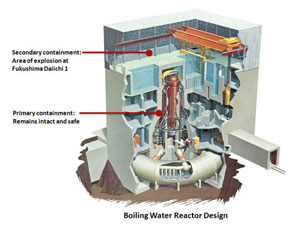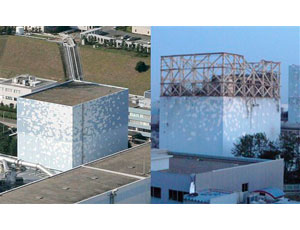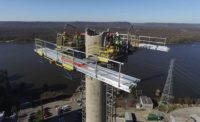Officials of Tokyo Electric Power Company were flooding two nuclear reactors at its Fukushima Daiichi plant with corrosive seawater and boron and planning to pump seawater into a third in attempt to cool the reactor cores damaged after the earthquake Friday.
Additionally, they are venting gas from at least one unit to prevent a dangerous pressure build up.
The reactor problems began following the magnitude 9.0 earthquake and tsunami that hit Japan Friday afternoon. The earthquake cut off power to the plant, and diesel generators intended to provide back-up electricity to the plant’s cooling system were disabled by tsunami flooding.
According to the Nuclear Energy Institute in Washington D.C, Japan’s Chief Cabinet Secretary, Yukio Edano, said on Sunday that officials are acting on the assumption that a meltdown could be under way at Fukushima Daiichi Unit 3.
The flooding of seawater followed an explosion from hydrogen buildup at unit 1 on Saturday, which Japanese officials said did not damage the core reactor building. The International Atomic Energy Agency says there were increased levels of radioactivity of caesium-137 and iodine-131 near unit 1 after the explosion and said that Japan reported it would distribute iodine to people potentially affected by radiation exposure.
According to the Nuclear Energy Institute in Washington D.C. the maximum reported dose at the site is 128 millirem per hour, which is less than the radiation the average American is exposed to per year from all sources.
TEPCO tried to flood the reactors with fresh water on Saturday, but when that effort failed, seawater was used to cool the reactors. The seawater and boron will more than likely permanently cripple the units.
Late Friday, IAEA Director General Yukiya Amano, a native of Japan, said that the Japanese authorities are working to handle the “difficult and constantly evolving circumstances.” While IAEA’s role in such nuclear crisis is to coordinate assistance from other members, Amano said that Japan has not yet asked for assistance.
Japan has declared the reactor problems a 4 on a sale of 1 to 7, with 4 as an accident with local consequences, and 7 as a major accident.
Secretary of State Hillary Clinton said Friday that the United States had sent coolant to Japan by the U.S. Air Force, but it was unclear whether the coolant had been used.
At least one person was reported dead after a crane accident at the site of the plant, and several others were reported injured.
The reactors at Fukushima are boiling water reactors (BWR), built in the late 1960s under a General Electric design. They produce steam used to generate electricity directly from the water flowing past the fuel roads. Without water flowing past the rods, the rods are exposed and can overheat. One of the units uses mixed-oxide fuel, or MOX.
Michael Tetuan, a spokesman for GE Hitatchi Nuclear, which traces its lineage to U.S firm General Electric, says that GE has offered its support, but TEPCO has not requested its help.
Japan’s 54 reactors provide an estimated 30% of the nation’s energy. All nuclear reactors are designed to shut down when seismic activity is detected, but without the emergency power at Fukushima, that design failed.
The World Nuclear Association, in its own literature, says that, “Even for a nuclear plant situated very close to sea level, the robust sealed containment structure around the reactor itself would prevent any damage to the nuclear part from a tsunami, though other parts of the plant might be damaged. No radiological hazard would be likely.”
The disaster at Fukushima is already generating debate about the future of nuclear power in the United States.
On Friday, Rep. Edward J. Markey (D-Mass.), a senior member of the House Energy and Commerce Committee, sent a letter to Nuclear Regulatory Commission Chairman Greg Jaczko requesting additional information on the potential impacts of today’s massive earthquake on Japan’s nuclear facilities as well as any implications for America’s domestic nuclear industry.
“This disaster serves to highlight both the fragility of nuclear power plants and the potential consequences associated with a radiological release caused by earthquake-related damage,” wrote Markey to Jaczko. “We must ensure that America’s nuclear power plants can withstand a catastrophic event and abide by the absolute highest standards for safety.”
Markey is urging the NRC not to approve Westinghouse’s design for a new nuclear reactor design, known as the AP1000, until what he calls serious safety concerns have been addressed. “Taxpayer dollars should not be spent on reactors that could be at risk of suffering a catastrophic core meltdown in the event of an aircraft strike or a major earthquake.”
The latest generation III+ reactors designed by Westinghouse, which did not want to be interviewed for this story, and GE Hitachi, have advanced passive safety systems that are designed to shut down more quickly and effectively in the event of any disaster.
Mitch Singer, a spokesman for NEI, said in an email response, “it is premature to draw conclusions from the tragedy in Japan with regard to the U.S. nuclear energy program. Japan is facing what literally can be considered a ‘worst case’ disaster and, thus far, even the most seriously damaged of its 54 reactors has not released radiation at levels that would harm the public. That is a testament to their design and construction, and the effectiveness of their employees and their emergency preparedness planning.
“There has not been a rush to judgment on the part of U.S. policymakers during the first few days of this situation. Why? Because we believe that is due in part to the recognition on their part that nuclear energy must continue to play a key role in a diversified energy portfolio that strengthens U.S. energy security and fuels economic growth,” he says.
In an interview with Bloomberg News on Friday, Seth Grae, CEO of nuclear power consultancy Lightbridge Corp., said the investigation into the incident will likely center on the backup systems. “This sounds to me like some sort of a common mode failure, or some problem that was common throughout the backup systems,” he said. “[They] should have been truly independent or redundant so that you wouldn’t have a failure of [four cooling pumps] like this all at once.” The plant, he added, was designed to withstand an earthquake of this magnitude.




Post a comment to this article
Report Abusive Comment